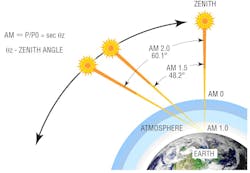JAY JEONG
Photovoltaic researchers have traditionally used a "reference solar cell" as a standard tool to determine the irradiance level generated from a solar simulator, while photonics researchers use a calibrated detector as a standard tool to measure the output of a light source. As photonics researchers become more interested in photovoltaics (PV) research, we can expect that versatile research tools will be in increased demand and become more generally accessible. An optical power meter and a thermopile detector can be good complementary tools for PV research.
The "sun" value
One sun is defined to be equivalent to the irradiance of one solar constant, and the solar constant is defined as the irradiance of the sun on the outer atmosphere at a distance of 1 AU Traditionally, measuring the sun for PV applications has been achieved using a silicon solar cell because silicon (Si) cells are the most popular type. A solar cell can be calibrated at a calibration lab, such as the National Renewable Energy Laboratory (NREL; www.nrel.gov), and is used as a reference to calibrate a solar simulator—hence the name "reference solar cell." Most terrestrial solar cells are tested under the global AM (air mass) 1.5 G (global) condition (see Fig. 1).
Ideally a calibrated reference solar cell would be kept in the lab all the time, but this can be expensive. In addition, as more researchers investigate alternatives to Si and the other traditional thin-film materials, the limitation of the silicon-based reference cells can sometimes be a problem, especially when measurements involve the spectral region outside the 400 to 1100 nm wavelength range.
Solar cell vs thermopile detector
A thermopile detector can be useful when the level of calibration required by PV standards bodies is not critical. An important question to ask at this point is whether a thermopile can be used as a reference cell. And the short answer is no, because the process and the measurement protocols for solar cells and NIST traceable thermopiles are clearly different. However, there is a common thread: the 'sun' is a radiometric unit. Ultimately, either one measures the irradiance of a light source, whether it be a solar simulator or any other source.
At AM 1.5 G condition, 1 sun is defined as equal to 100 mW/cm2 of irradiance (see IEC 904-3). For AM 1.5 standard spectra are defined by the American Society for Testing and Materials (ASTM; see Fig. 2).The most broadly used solar condition is the AM 1.5 G condition for commercial terrestrial PV applications. However, other conditions are often used, especially for extraterrestrial satellite PV applications. At AM 0, for example, the total irradiance for 1 sun is about 135 mW/cm2. Due to the spectral changes in the different air mass conditions, a solar cell calibrated for standard AM 1.5 G cannot work as a reference solar cell for other conditions because the relationship between the current generation and the illuminated light intensity is not linear. It is possible, however, with a calibrated detector that has a flat response throughout the solar spectrum. Here the relationship is linear so a simple correction factor can be applied and the readings are still accurate.
One area of caution regarding the thermopile detector: often the whole detector body is exposed to the solar simulator illumination. In this case the growing temperature of the detector body throws off the calibration responsivity of the material. If the detector is illuminated under a solar simulator for too long, it can produce incorrect readings. However, the situation is the same with silicon solar cells. A possible solution to this thermal walk-off is the use of an aperture on top of the detector so that only the active area is exposed to the illumination. Also, the response of a thermal detector can be very slow—on the order of 10 s. Nowadays, however, many optical power meters come with software or hardware that speeds up reading the final steady-state value to within two or three seconds so the measurement can be made fairly quickly with thermal detectors as well.
Detector versatility
One exciting area in PV development is the concentrators. Certain cells like gallium arsenide (GaAs) based multijunction solar cells are most efficient when the light intensity is much higher than 1 sun. A typical design uses a Fresnel lens of about 12 x 12 in. to focus sunlight onto a multi-junction cell that's on a mount with highly efficient thermal dissipation. Light intensity generally increases to several thousands of the sun value. It is equivalent to having several hundreds of watts per cm2 irradiance. At this point, thermopile detectors have tremendous advantages. First, they typically have a high power handling capability with a very high power-density damage threshold and second, the optical power and the output voltage have a linear relationship.
Recent PV research includes development of new solar cells that can potentially improve the cell efficiency with new structures, improved radiation absorption, different materials, and improved light-matter interaction. Noble materials typically have absorption bands larger than existing PV materials and often the researchers want to know the characteristics in the near-infrared spectrum. In this case, a Si reference solar cell is not much help because of its lack of response above 1100 nm. This leads to a further requirement that ideally a reference cell is needed for each type of material and/or structure, so that the spectral mismatch between the reference cell and the test cell is minimized—which can be very costly. Alternatively, the spectral mismatch correction factor must be taken into account in calculating the cell efficiency.1 Again, the flat response of a thermopile detector is a tremendous advantage because the reading is unaffected by changing spectral content of the solar simulator.
REFERENCES
1. V. Shrotriya et al., Adv. Funct. Mater. 2006, 16, 2016-2023.
JAY JEONG is senior product marketing manager at Newport Corporation, Irvine, CA; e-mail: [email protected]; www.newport.com.


